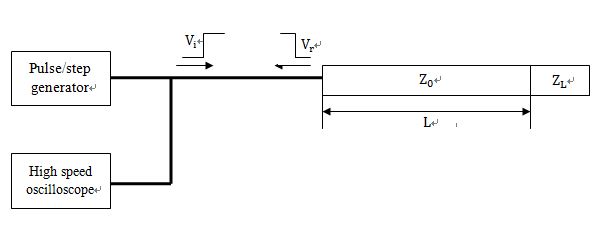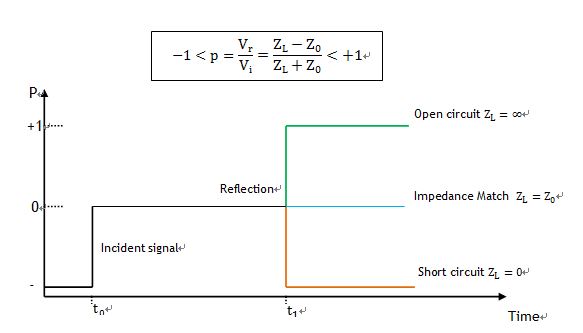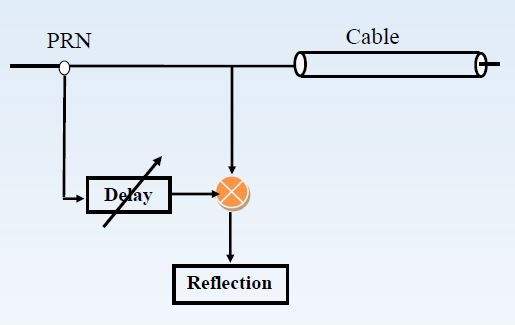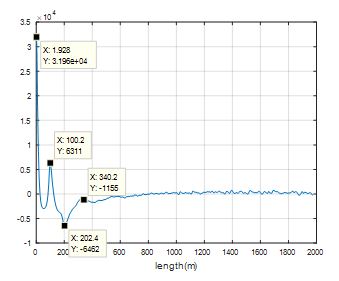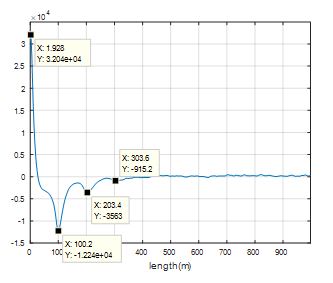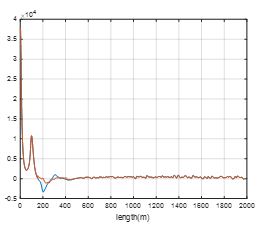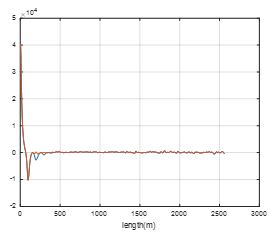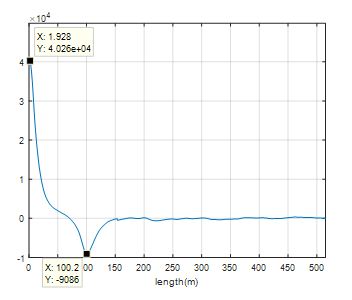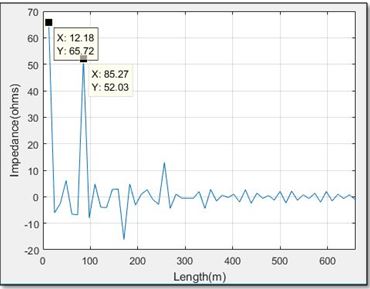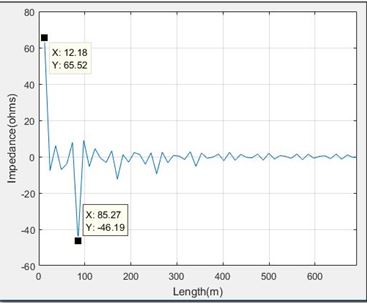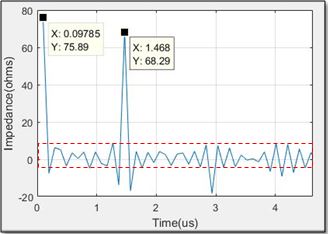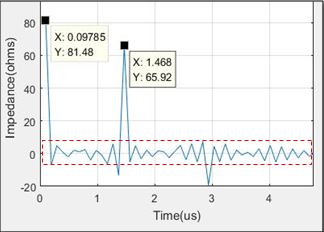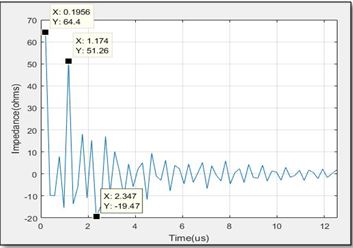Projects:2016s2-250 On-Line Mains Power Cable Time Domain Reflectometry
Contents
Supervisors
Dr. Cornelis Jan Kikkert, Dr. Nesimi Ertugrul
Group members
Jinyue Bai, Shuxin Tang
Abstract
This project has investigated two possible techniques which can be used to measure on-line reflections to provide on-line Time Domain Reflectometry(TDR). Convertional Time Domain Reflectometer cannot be connected directly to the mains when the power system is operational. In such situation, a method for localization of on-line power line faults would be desirable. Two possible methods were investigated in this project, including: 1) Spread Spectrum Time Domain Reflectometry (SSTDR) techniques with a pseudo random sequence as the transmitted input signal on the power-line using the cross-correlation technique to capture the reflections in time domain;2) measuring the line impedance in the frequency domain by the Resistive Shunt On-line Impedance Analyser(RSOIA), which was developed by Kikkert[1,2], and using Fast Fourier Transform(FFT) to obtain the impulse response in time domain. Both method was performed under off-line and on-line conditions. Both measurements were performed with relatively high accuracy, sensible and can easily obtain the results. The advantages and limitations of both methods were illustrated and demonstrated that the correlation technique for the spread spectrum Time Domain Reflectometry gave more accurate results, especially in the detection of soft faults.
Background
Transmission cables carry data or power to customers. The quick repair of any fault in a cable is essential to ensure the system reliability. By injecting a signal and observing its reflection, one can quickly locate any fault or discontinuities, to facilitate any repairs that may be required. A traditional TDR instrument cannot be used when the transmission line is powered up as the mains voltages will damage the TDR. The instrument developed for this project rejects mains voltages and allows TDR techniques to be applied on-line. By using correlation techniques, the signal to noise ratio is enhanced to improve the detection accuracy.
Time Domain Reflectometry
The basis of TDR is the principle of reflection of signals due to the impedance at the fault points differs from its characteristic line impedance (impedance mismatch). Any fault or discontinuities such as junctions of cables can be identified from the reflected signal which can be calculated by reflection coefficient. If the cable has an open circuit then the amount of reflected signal is positive due to the extremely large value of Z_L. If a cable is under short circuit condition, then the amount of reflected signal becomes negative since the value of Z_L is approximately zero.
Project outline
The aim of the project is to investigate possible methods to measure any reflections from power line discontinuities or faults. Two techniques have been developed and tested: 1) SSTDR using pseudo random signals and 2) Measuring the line impedance in the frequency domain and using the FFT to obtain the impulse response. A high-pass filter provides mains rejection to en-sure the reflections can be measured while the line is powered up.
SSTDR(Correlation)
Essentially, correlation technique is spread spectrum time domain reflectometry. Emitting the pulse (pseudo random noise) from signal generator to the cable discontinuities and then getting the reflections by correlating the sending pulse with the received signal which acquired from oscilloscope (PicoScope).
Offline measurement
Use 4x25m extension cords Measurement Result:100m
The impedance is not matching for the test system, due to the 12.5-ohm resistor and 2.5μF capacitor as well as the high-pass filter inside the impedance analyser, which does not equal to 50-ohm. It will have oscillating reflection backwards and forwards until normal noise level.
calibrated measurement (offline)
The calibrated results show above have the similar waveform as the resistor matching test, which means the effect of impedance mismatch has been removed. The open-circuited calibrated result has slight difference because the oscillation changes direction each times to arise error.
Online measurement
Connecting 4x25m extension cords to the power point at the Electrical and Electronic Engineering (EEE) laboratory. The result shows a negative reflection for a lower impedance. The low impedance value is mainly caused by a plenty of instruments are connected to the test power point. Hence, those electric instruments are parallel-connected together to get a low impedance.
Impulse Response(FFT)
• The RSOIA obtains the on-line characteristic impedance of the power line, using a linear frequency sweep.
• Those results are converted to an impulse response using the FFT.
• That shows any reflection on the cable.
Offline measurement
Use 85.15m coaxila cable Measurement Result:85.27m
The reflection results are affected by different signal-to-noise ratio (SNR). The possible causes of such issue are the high pass filter installed in the RSOIA and the Gibbs oscillations.
New calibration of open and short circui in RSOIA
A new calibration technique for open and short circuit was given in the [2] for the RSOIA. Hence, the impedance measurement result became more accurate. The following figures shows that the new calibration technique was applied to determine our new reflections.
Online measurement
The RSOIA was connected directly to a phase of the mains in the EEE workshop. The result shows a Positive reflection for a higher impedance. It might be caused by circuit junction with higher impedance. Although it might be difficult to determine the fault type exactly, the on-line measurement can still be made to obtain the sensible results at some extent.
Comparisons
• Accuracy
Both methods have very good performance with relatively high accuracy, while correlation technique is better with higher resolution.
• Speed comparison
Impulse response needs to take more than 30 minutes for a set of data, while correlation only needs a minute.
• Limitations
Correlation cannot provide an impedance value directly from discontinuities. For both techniques the distance resolution is deter-mined by the signal bandwidth. (20 MHz—7.5m)
Conclusion
The aims of the project have been achieved and two new reliable techniques for measuring online reflections on power line have been developed. The two different methods have been found to be able to provide accurate measurements, both on-line and off-line.
Reference
[1] C.J. Kikkert and S. Zhu, “Resistive shunt on-line impedance analyzer”, in International Symposium on Power Line Communications and its Applications, pp. 150-155, 2016.
[2] C.J. Kikkert and S. Zhu, “Design improvements of the resistive shunt online impedance analyser”, unpublished.
